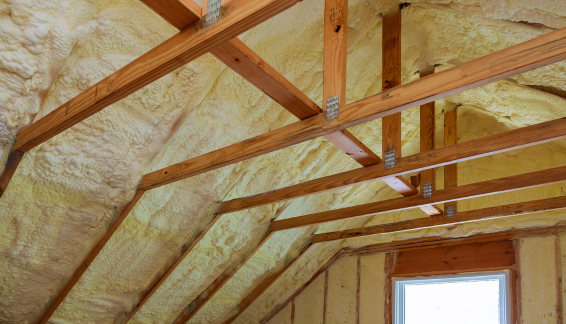Insulating a flat roof from the inside is an increasingly popular choice among UK homeowners, especially those seeking to enhance their home’s energy efficiency and comfort. This method not only improves thermal performance and reduces heat loss but is also a cost-effective alternative to the more expensive process of removing and replacing the roof’s top layer.
However, it’s crucial to approach this task cautiously, as improper insulation can lead to long-term damage to your roof. In this article, we’ll guide you through the essential steps and considerations for how to insulate a flat roof from the inside, ensuring you make the most of your roofing investment.

Warm Roof Vs. Cold Roof
Understanding how to insulate a flat roof begins with distinguishing between warm and cold flat roofs. These terms often cause confusion, but the difference is straightforward and lies in the placement of the insulation.
In a warm, flat roof, the insulation sits above the structural timber deck, effectively on the exterior side of the top, keeping it ‘warm.’ Conversely, a cold flat roof features insulation between the rafters and the deck, placing it inside the roof, hence on the cold side.
When deciding whether to opt for a warm deck roof construction or a cold roof construction and what type of insulation to use, there are several factors to consider. Warm flat roofs are favoured in the UK for their ease of installation and superior thermal performance. However, they can raise the height of your home, which might conflict with local Building Regulations or neighbourly relations.
On the other hand, cold flat roofs are more durable for foot traffic, as you walk on the timber decking rather than on potentially compressible insulation boards. But, they do not perform as well thermally due to the exposure of the rafters.
Considering these considerations, it’s essential to weigh the pros and cons of both warm and cold flat roofs to determine the best approach for your specific needs and how to insulate your flat roof effectively.
How To Insulate A Flat Roof From The Inside?
When considering how to insulate a flat roof from the inside, especially for a cold roof, it’s crucial to understand the structure and necessary components. A typical cold roof includes six main elements aligned with BS 5250: 2021 standards for building moisture management. These elements are:
- Waterproofing layer
- Timber deck
- Timber joists
- Insulation
- Vapor Control Layer (VCL)
- Plasterboard ceiling
An additional key component is a ventilation layer, which is essential for preventing moisture issues. Without a 50-60mm ventilation space between the roof and insulation, moisture from inside the home can accumulate, leading to condensation and, over time, significant structural damage.
To insulate your flat roof from the inside, follow these steps:
- Remove the plasterboard ceiling carefully and set it aside.
- Ensure there is an adequate ventilation layer.
- Install cold flat roof insulation boards between the timber joists, adhering to the manufacturer’s guidelines.
- Place a VCL directly underneath the insulation boards.
- Finally, reinstall the plasterboard ceiling.
By following these steps, you’ll successfully create an insulated cold roof from the inside, effectively enhancing your home’s insulation while avoiding potential moisture problems.
How To Insulate A Flat Roof From The Outside?
When considering how to insulate a flat roof from the inside, especially for a cold roof, it’s crucial to understand the structure and necessary components. A typical cold roof includes six main elements aligned with BS 5250: 2021 standards for building moisture management. These elements are:
- Waterproofing layer
- Timber deck
- Timber joists
- Insulation
- Vapor Control Layer (VCL)
- Plasterboard ceiling
An additional key component is a ventilation layer, which is essential for preventing moisture issues. Without a 50-60mm ventilation space between the roof and insulation, moisture from inside the home can accumulate, leading to condensation and, over time, significant structural damage.
To insulate your flat roof from the inside, follow these steps:
- Remove the plasterboard ceiling carefully and set it aside.
- Ensure there is an adequate ventilation layer.
- Install cold flat roof insulation boards between the timber joists, adhering to the manufacturer’s guidelines.
- Place a VCL directly underneath the insulation boards.
- Finally, reinstall the plasterboard ceiling.
By following these steps, you’ll successfully create an insulated cold roof from the inside, effectively enhancing your home’s insulation while avoiding potential moisture problems.
How To Insulate A Flat Roof From The Outside?
Insulating a flat roof from the outside, known as constructing a warm roof, is a popular method in the UK. Here’s a step-by-step guide on how to do this:
- Foundation Layer: Start by laying a foundation of either 12mm plywood or OSB board on the timber joists. This acts as a sturdy base for the subsequent layers.
- Vapor Control Layer (VCL): Next, install a vapour control layer to prevent condensation and moisture from damaging the structure. Mark the positions for fixings through the VCL at regular intervals using the rafter centres as a guide.
- Sealing Points: Apply butyl tape at each point where the fixings will penetrate the VCL to ensure a tight seal.
- Insulation Thickness: Choose the thickness of your warm roof insulation based on the available height for accommodating guttering. This is a critical step as it determines the roof’s thermal performance and water drainage.
- Second Layer of Decking: Place another layer of plywood or OSB board on top of the insulation boards. This adds structural integrity and a base for the final layer.
- Securing the Structure: Use helical fixings to securely join the deck layers, ensuring that these fixings penetrate through every layer of the roof build-up, including the flat roof boards.
- Waterproofing: The final step is to install a waterproof membrane over the top. This is crucial for protecting the entire structure from weather elements and ensuring longevity.
By following these steps on how to insulate a flat roof from the outside, you can efficiently construct a warm roof that is durable, thermally efficient, and compliant with UK building standards.
Benefits Of Insulating Your Roof
Insulating your roof is a smart home improvement move that offers many benefits. It not only enhances the comfort of your living space but also contributes to energy efficiency and cost savings. Here are some key advantages:
- Energy Efficiency: Roof insulation significantly reduces heat loss in winter and heat gain in summer, leading to lower energy bills.
- Comfort: A well-insulated roof helps maintain a consistent indoor temperature, making your home more comfortable year-round.
- Noise Reduction: Insulation acts as a sound barrier, reducing external noise pollution and creating a quieter, more peaceful home environment.
- Environmental Impact: Roof insulation reduces carbon emissions by reducing energy consumption, making it an environmentally friendly choice.
- Increased Property Value: Homes with effective insulation are often more attractive to buyers, potentially increasing your property’s market value.
- Prevention of Ice Dams: In colder climates, roof insulation can help prevent ice dams, which occur when heat escapes and melts snow on the roof, potentially leading to water damage.
- Moisture Control: Proper insulation helps regulate moisture levels, reducing the risk of mould and mildew growth in your home.
Conclusion
In conclusion, insulating a flat roof, whether from the inside or outside, is essential for homeowners looking to enhance their property’s comfort, energy efficiency, and overall value.
The benefits of roof insulation extend beyond mere energy savings, offering improved indoor comfort, noise reduction, environmental benefits, and increased property value. Whether you opt for a warm or cold roof construction, the importance of proper installation and attention to detail cannot be overstated.
By following the guidelines outlined in this article, you can ensure a successful insulation project that will serve you well for years. Remember, insulating your flat roof is not just a home improvement task; it’s an investment in your home’s future.
Read more: What Is Room In Roof Insulation?


